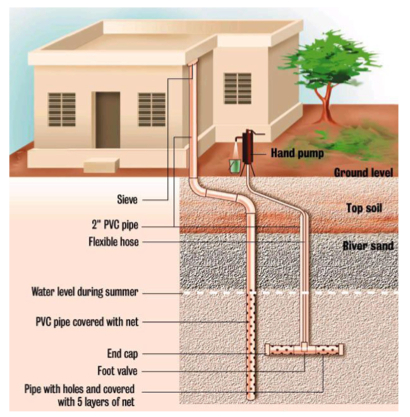Well shafts and boreholes
Large diameter wells and smaller diameter boreholes can be used to directly recharge or dilute aquifers where low permeability strata (rock) overlie the aquifers and where other infiltration methods are not effective. The important thing is that water of high enough water quality is used for this purpose. Although this method of recharge is practised with deep and high-yielding boreholes, this technique mainly describes recharge at family level in areas where hand dug wells run dry at the end of the dry season or where groundwater is saline.
Contents
Suitable conditions
- Site only in areas where rainwater does not infiltrate fast enough where there is high runoff.
- Avoid where there is a risk of chemical contaminants entering the well, e.g. fertilizers and pesticides from agriculture, and when the final
water abstracted will be used for drinking.
Construction, operations and maintenance
Water source considerations
Water to be recharged should be high quality since blockage due to suspended sediment, microbial growth or chemical precipitation is more likely over the smaller infiltration area of a well or borehole. In Namibia, water from the water treatment works is further treated with granular activated carbon and chlorination before being injected to avoid such problems. In certain cases in India, open large diameter wells that ran dry due to falling water tables (resulting from overexploitation) are being used to recharge shallow aquifers directly from runoff water that enters the wells – the problem with such structures is that there is no process of water infiltrating through the soil to the aquifer, which would not only reduce sediment and microbiological load, but also have potential chemical contaminants like nitrates and pesticides. Direct recharge of untreated water via open wells is therefore discouraged in preference to infiltration through a soil or sand layer.
One source of higher quality water that is a realistic source of recharge water is rainwater from roof catchments. This has been used to recharge shallow aquifers in Mozambique where groundwater was saline, with the result that the water was diluted. Ground runoff is also being used where potentially contaminated runoff water is used to recharge aquifers but where it still must infiltrate a certain amount of soil later – however the risk of aquifer contamination and screen blockage is increased. Hand dug wells that previously dried up now have water all year round – an evaluation after 3 years showed that out of 120 hand-dug wells that had recharge boreholes created close by to aid recharge, very few were drying up like they were before. In addition, families in the area were starting to replicate the system on their own.
Construction
- The tubewell is sited 5 – 10 meters “upstream” from a well or borehole that dries up in the dry season, or in an area of saline groundwater.
- When taking water directly from a roof, ensure that the downpipe has a sieve on the inlet and a first flush system.
- A hole (e.g. 2”) is drilled with a step auger or a soil punch. The depth should be such that it passes the compact top layers and reaches the permeable layers – in general 4 – 6 meters is enough depending on the site.
- The recharge hole should not reach the groundwater layer aquifer to avoid contamination of the groundwater with surface water. Ideally the minimum distance should be 1.5m above the water table and 5 metres from an abstraction point such as a hand dug well. The water table can be known by observation in the hand-dug well.
- Test the recharge capacity of the hole after drilling by filling up the hole with water. It should absorb at least 2 litres per minute – if not, drill deeper.
- Plug the hole (e.g. with a cloth) to prevent debris entering, and make a small pond around the hole (0.5 – 1 metre deep, 1 – 5 metre diameter). Ensure the hole is on one side of this pond so that it can be accessed from ground level. The size of the pond depends on the required storage capacity, the infiltration capacity of the soil and the rainfall pattern but in general will be between 1 – 10m3.
- Remove the plug and fill up the hole with gravel (5 – 30mm) until 2 metres from ground level.
- Install a filter which will screen out solid particles (e.g. leaves etc). This can be done using a PVC screen or sand filter, depending on the incoming water quality:
1) PVC filters are used in combination with ground runoff: 2) In general it is best to reduce the speed of the water as much as possible to avoid the pond from filling up with sand and clay – this can already be done by planting grasses and other catchment methods (see “Natural ground catchment & open water reservoir” for details) . 3) The PVC filter pipe can be between 25 – 100mm and acts as a screen to allow water to infiltrate into the gravel layer (i.e. PVC has horizontal slots cut in the side). The pipe protrudes just above the base of the pond. 4) A PVC cover piece is fabricated which is closed at the top and flares at the base so that it fits over the protruding pipe – the purpose of the cover is to prevent too many sediments entering the pipe and is removed only 4 hours after rainfall. Once water has infiltrated, the cover is replaced until the next time. 5) Cleaning involves swabbing the inside of the PVC with a cloth.
- Sand filters can also be used instead of the PVC filter system – this is where sand replaces the need for a cover piece and the need to wait 4 hours. It can be used with rooftop catchments where no surface runoff enters the hole, and could be done with or without a PVC pipe.

